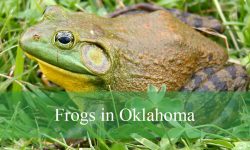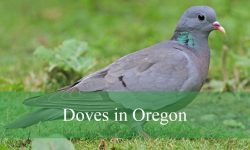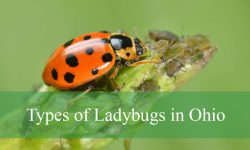If there’s one group of insects that makes homeowners uneasy, it’s the cockroach. Pennsylvania is home to a surprising variety of roach species—some harmless forest dwellers, others unwelcome invaders in kitchens and basements. Understanding which type you’re dealing with is the first step toward effective control and prevention.
While most people only recognize the common German or American cockroach, the state also hosts species like the Pennsylvania Wood Cockroach and the Oriental Cockroach, each with unique habits and appearances. Some thrive outdoors under bark and leaf litter, while others prefer the warmth of human dwellings year-round.
This guide explores 10 types of roaches found across Pennsylvania, complete with pictures, identification details, behavior insights, and habitat preferences. Whether you live in a bustling city or a quiet rural area, recognizing these insects can help you manage them safely and protect your space from infestations.
Different Types of Roaches Found in Pennsylvania
German Cockroach (Blattella germanica)
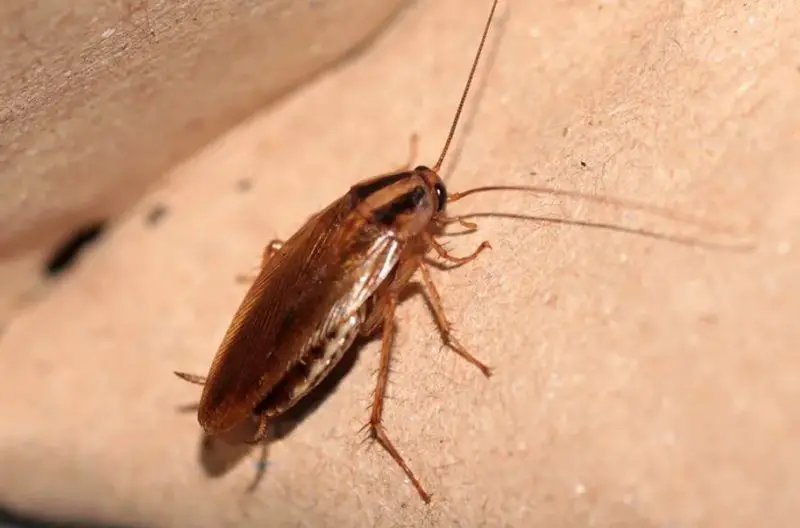
The German cockroach is the most widespread and troublesome species in Pennsylvania households. These small insects measure about 0.5 to 0.6 inches in length and are easily recognized by their light brown or tan bodies marked with two distinct dark stripes running parallel down the pronotum behind their heads. Their wings cover their entire bodies, but they rarely fly, instead relying on quick, darting movements to escape danger.
This roach prefers warm, humid environments close to food and water sources, making kitchens, bathrooms, and laundry rooms ideal hiding spots. They are nocturnal, spending daylight hours hiding in cracks, under appliances, or inside cabinets. German cockroaches reproduce rapidly; a single female can produce hundreds of offspring in a year, leading to severe infestations if not controlled.
Their diet is highly adaptable—they consume crumbs, grease, food residues, and even soap or glue if necessary. Because of their preference for human habitats, they are considered major indoor pests and can spread bacteria such as Salmonella and E. coli. They are also known to trigger allergies and asthma, especially in children.
In Pennsylvania, German cockroaches are active year-round indoors since they rely on warm, stable conditions. Infestations typically occur in multi-unit dwellings, restaurants, and grocery stores, where they can easily move between rooms through shared walls and plumbing systems.
American Cockroach (Periplaneta americana)
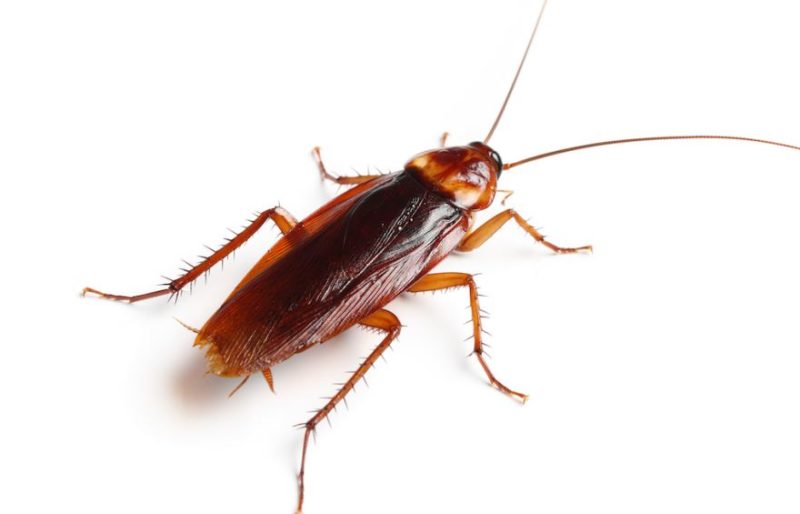
The American cockroach is one of the largest cockroach species found in Pennsylvania, measuring between 1.4 and 2 inches long. These roaches are reddish-brown with a distinctive yellowish figure-eight pattern on the back of their heads. Both males and females have fully developed wings and can glide short distances when disturbed. Their size and fast movements make them particularly startling when seen indoors.
They prefer dark, warm, and moist areas such as basements, boiler rooms, sewers, and utility tunnels. Although they can survive outdoors, American cockroaches often migrate indoors during colder months or after heavy rain. Their strong preference for decaying organic matter means they are commonly associated with unsanitary areas.
These cockroaches are omnivorous scavengers that feed on food scraps, paper, leather, and even dead insects. They are known to contaminate surfaces with pathogens, contributing to food poisoning and allergic reactions. Because of their ability to fly and squeeze through small gaps, they can easily spread throughout large commercial buildings and warehouses.
In Pennsylvania, American cockroaches are mostly found in urban areas like Philadelphia and Pittsburgh, where older sewer systems and damp basements provide ideal environments. They are less common in rural homes but may infest barns, basements, and storage sheds during warm, humid summers.
Oriental Cockroach (Blatta orientalis)
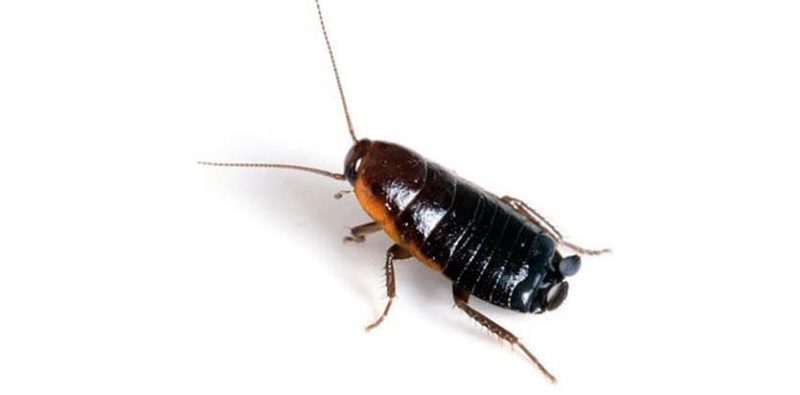
The Oriental cockroach, sometimes called the “water bug” or “black beetle roach,” is a dark, glossy species that thrives in cool and damp places. Adult females measure about 1 inch long, while males are slightly smaller and have short, rudimentary wings that do not allow flight. Their bodies are dark brown to nearly black, giving them a beetle-like appearance.
They are strongly associated with moisture and often inhabit basements, drains, crawl spaces, and under porches. Outdoors, they live in leaf litter, mulch, or near decaying vegetation. Unlike German cockroaches, Oriental cockroaches are slower and less agile, relying on their ability to hide rather than speed.
This species has a slower reproductive rate compared to other roaches but can still form large infestations if left unchecked. They are particularly active during spring and early summer when temperatures rise. Their diet includes decaying organic matter, garbage, and leftover food, contributing to foul odors in infested areas.
In Pennsylvania, Oriental cockroaches are common in older neighborhoods and homes with damp basements or poor drainage. Because they are more tolerant of cold temperatures, they can survive outdoors longer than most other roaches, retreating indoors during harsh winters.
Brown-banded Cockroach (Supella longipalpa)
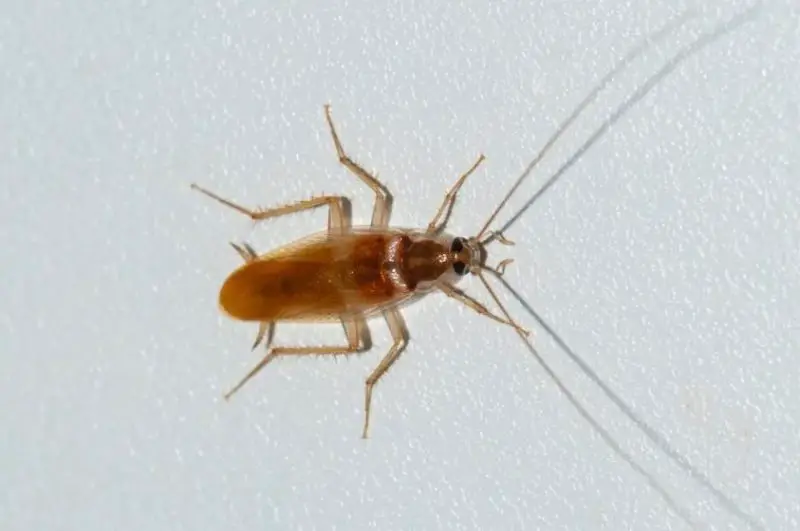
The Brown-banded cockroach is a small species that measures about 0.4 to 0.5 inches in length. It can be identified by the light brown or yellow bands that run across its wings and abdomen. Males have longer wings that extend past the tip of the abdomen, while females’ wings are shorter and broader. Unlike many other roaches, they prefer warm, dry locations rather than moist environments.
This species often hides in higher locations such as ceilings, behind picture frames, electrical outlets, or inside furniture. Their preference for dry heat makes them common in apartments, offices, and heated buildings. They are nocturnal but can occasionally be spotted during the day when disturbed.
Brown-banded cockroaches feed on a wide range of materials, including food crumbs, glue, and even paper. They reproduce quickly, and their oothecae (egg cases) are often attached to hidden surfaces instead of being carried by the female. Infestations can spread unnoticed since they tend to occupy areas far from kitchens or bathrooms.
In Pennsylvania, these cockroaches are frequently encountered in modern heated homes and office spaces, especially during winter when heating systems create ideal dry conditions. They are less dependent on moisture than German cockroaches, allowing them to survive in diverse indoor environments.
Smokybrown Cockroach (Periplaneta fuliginosa)
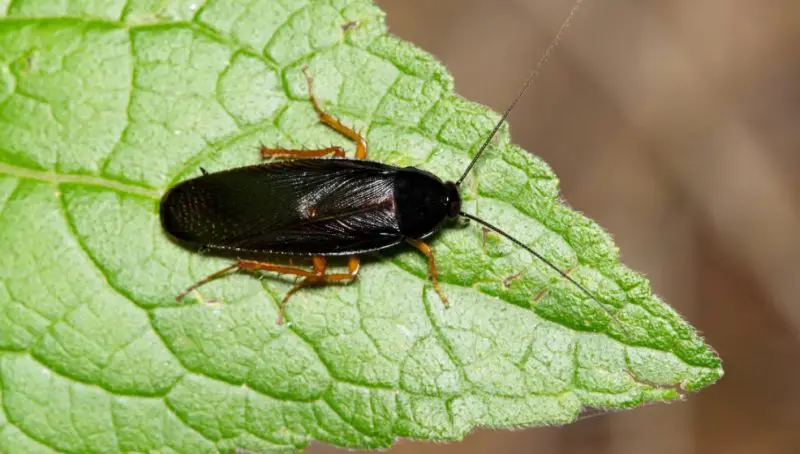
The Smokybrown cockroach is a large, glossy insect that measures between 1 and 1.5 inches long. It is uniformly dark mahogany or chocolate brown, with a shiny appearance and long wings extending beyond the body. Both sexes are capable of sustained flight, which they often use to reach light sources at night.
This species thrives in warm, humid outdoor environments such as woodpiles, tree holes, and leaf litter. They often enter homes through attic vents, chimneys, or gaps in siding during summer. Because they are highly dependent on moisture, they rarely establish long-term infestations indoors unless conditions are humid.
Smokybrown cockroaches are strong fliers and nocturnal feeders. They consume decaying plant material, food waste, and even bird droppings. Their presence indoors usually indicates nearby outdoor populations or structural moisture problems. Unlike German or Brown-banded roaches, they do not reproduce as rapidly inside homes.
In Pennsylvania, Smokybrown cockroaches are less common than in southern states but can appear during warm, wet summers, particularly in the southeastern regions. They are more likely to be found outdoors but may occasionally invade homes seeking shelter during hot or rainy periods.
Pennsylvania Wood Cockroach (Parcoblatta pennsylvanica)

The Pennsylvania wood cockroach is a native species often mistaken for its household relatives, though it rarely becomes an indoor pest. Males are about 0.75 to 1 inch long, with fully developed wings and a chestnut brown color, while females are shorter and darker with shorter wings that don’t cover their entire abdomen. Their bodies have a smooth, shiny appearance, and males are strong fliers that are frequently drawn to outdoor lights at night.
These cockroaches primarily live outdoors in wooded areas, hiding under loose bark, decaying logs, and piles of leaves. They thrive in moist environments where rotting wood and organic debris are abundant. During late spring and summer, males often fly toward porch lights, entering homes accidentally through open doors or windows. However, they cannot reproduce indoors and die off quickly without proper humidity.
Their diet consists mainly of decaying plant matter, bark, and leaf litter. They play an important role in natural decomposition and nutrient cycling within forest ecosystems. Unlike household pests such as German cockroaches, wood cockroaches do not contaminate food or spread diseases.
In Pennsylvania, this species is found throughout the state, especially in forested or rural regions. They are most active during warm months and may temporarily appear indoors during mating season. Maintaining sealed windows and reducing outdoor lighting at night can help prevent unwanted visits from male wood cockroaches.
Field Cockroach (Blattella vaga)
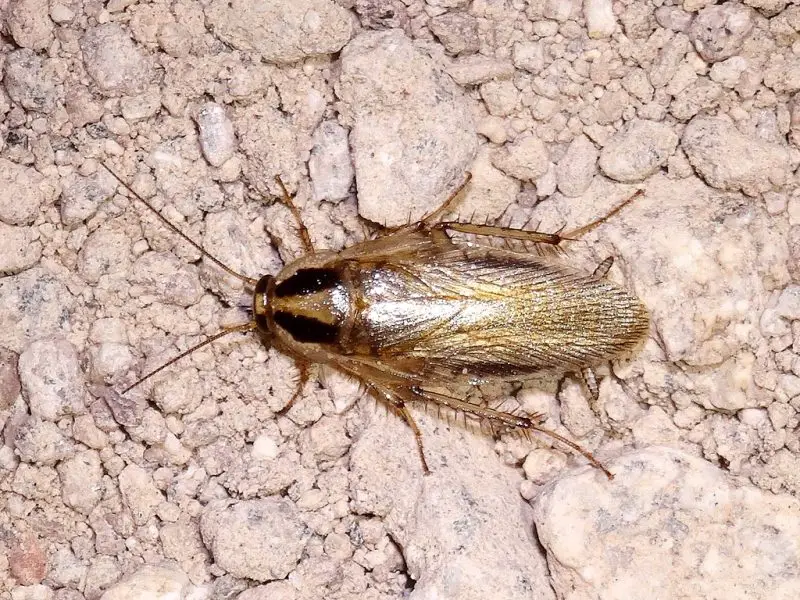
The field cockroach is a small, light tan species measuring about 0.4 to 0.5 inches long. It closely resembles the German cockroach but has a more olive-green tint and a darker mark between its eyes. Both males and females have wings that cover the entire abdomen, allowing them to glide short distances when disturbed. This species is primarily outdoor-dwelling and rarely infests human structures.
Field cockroaches live in leaf litter, mulch, and moist soil where decaying vegetation provides both food and shelter. They are most active during warm weather and can be found under stones, logs, or in garden debris. When temperatures drop or during heavy rains, they may occasionally wander indoors through gaps or open windows.
Unlike German cockroaches, field cockroaches are not attracted to indoor food sources. They feed mainly on decaying plant matter and other organic debris, which makes them more beneficial than harmful in natural environments. Indoors, they generally cannot survive long because of the lack of suitable moisture and food.
In Pennsylvania, these cockroaches are not widespread but can appear in southern or urban areas during hot summers. They are more common in gardens, compost piles, and landscaped yards, where they help break down organic material. Keeping vegetation trimmed and removing leaf litter near buildings reduces the likelihood of accidental indoor encounters.
Surinam Cockroach (Pycnoscelus surinamensis)
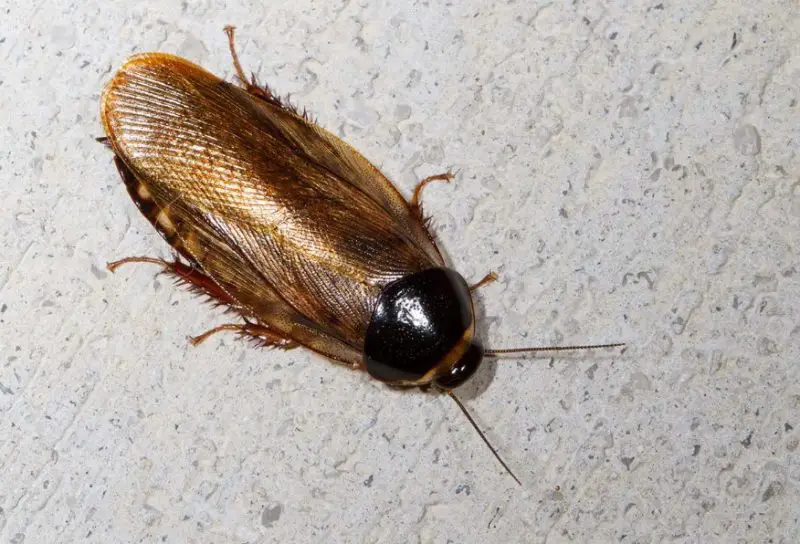
The Surinam cockroach is an unusual, burrowing species that thrives in warm, moist environments. Adults measure around 0.75 to 1 inch in length and have glossy, dark brown bodies with lighter brown or tan wings. Females are winged but do not fly, while males are extremely rare; reproduction occurs through parthenogenesis, meaning all offspring are female and produced without mating.
These cockroaches prefer to live in soil, mulch, and potted plants, making them a common pest in greenhouses and plant nurseries. They burrow into the soil during the day and come out at night to feed. Their diet consists mostly of decaying vegetation, roots, and plant debris, but heavy infestations can occasionally damage plant roots.
Because they require constant warmth and humidity, Surinam cockroaches cannot survive outdoors year-round in Pennsylvania. However, they can persist indoors in heated greenhouses, botanical gardens, or even inside homes with potted plants. They are rarely found in kitchens or bathrooms, preferring soil-based habitats instead.
In Pennsylvania, infestations are typically limited to greenhouses or indoor plant collections. To control them, removing infested soil and repotting plants can be effective. Maintaining proper sanitation and avoiding overwatering also helps prevent their spread in enclosed growing environments.
Australian Cockroach (Periplaneta australasiae)
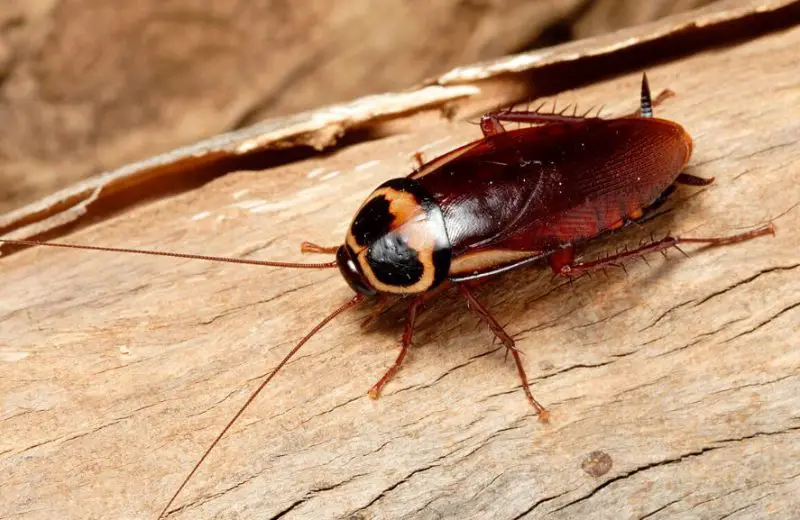
The Australian cockroach is a large, reddish-brown species similar in appearance to the American cockroach but slightly smaller, averaging 1.2 inches long. It can be distinguished by the bright yellow markings along the edges of its wings and around the thorax. Both sexes are capable fliers and are often attracted to lights at night. Their glossy, elongated bodies and swift movements make them easily noticeable when indoors.
This roach prefers warm, humid climates and is more commonly found outdoors in greenhouses, gardens, and near decaying vegetation. They may occasionally enter buildings during warm months through open windows or vents. Indoors, they tend to hide in attics, basements, or near moisture sources.
Australian cockroaches feed on plant material, decaying matter, and starchy foods. They are not aggressive indoor breeders like German cockroaches, but they can survive long enough to cause contamination issues if left unchecked. Because they thrive in temperatures above 70°F, Pennsylvania’s cold winters limit their outdoor survival.
In Pennsylvania, sightings are rare and typically limited to heated environments such as greenhouses or botanical facilities. They are considered accidental invaders rather than established pests. Reducing indoor humidity and sealing entry points helps prevent these tropical roaches from lingering inside structures.
Cuban Cockroach (Panchlora nivea)
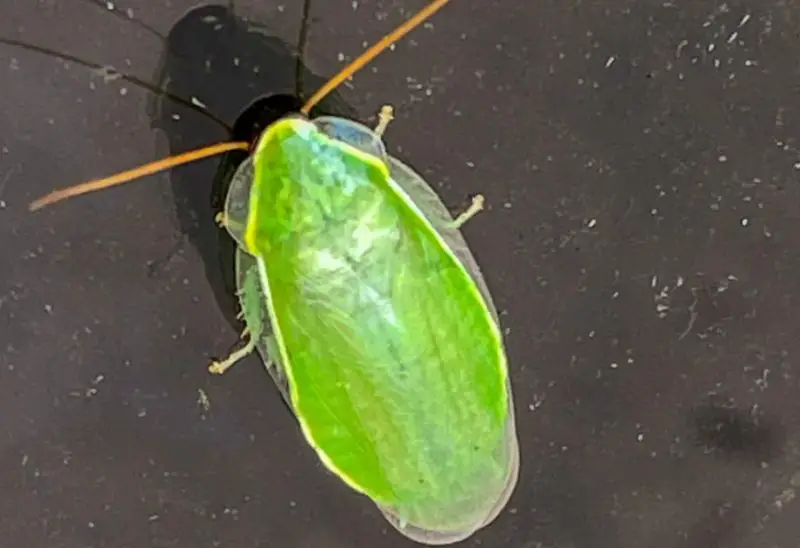
The Cuban cockroach is one of the most visually striking species found in Pennsylvania. Adults are bright, leaf-green and measure about 0.7 to 1 inch long. Their wings are fully developed, and both males and females are excellent fliers. Nymphs, however, are brown and wingless, resembling typical ground-dwelling roaches until they mature. Their delicate green coloration often causes them to be mistaken for leaf insects.
Native to tropical regions, Cuban cockroaches prefer warm, moist environments such as greenhouses, plant nurseries, or gardens. They are attracted to lights and are most active during the evening. Unlike most other roaches, they are not attracted to human food and do not typically infest homes. Instead, they feed on decaying plant matter and other organic debris.
These roaches are harmless and are sometimes even kept as pets or feeder insects due to their non-aggressive behavior. Their presence indoors is usually accidental, often introduced through imported plants, produce, or soil. They do not reproduce indoors unless conditions are consistently warm and humid.
In Pennsylvania, Cuban cockroaches are considered uncommon and are mainly encountered in greenhouses or plant shipments. Their tropical nature prevents them from surviving cold winters outdoors. Managing greenhouse humidity and inspecting imported plants can help prevent accidental introductions of this exotic species.
Tips for Identifying and Managing Roaches in Pennsylvania
Observe Their Appearance and Movement
Identifying roaches begins with careful observation of size, color, and body shape. German cockroaches are small and light brown with dark stripes, while American and Smokybrown cockroaches are much larger and reddish-brown. Oriental cockroaches are dark and shiny, resembling beetles, and Brown-banded roaches have distinctive tan bands across their wings. Watching how they move can also help—German cockroaches run quickly, while Oriental roaches are slower and prefer hiding in damp spaces.
Check Common Hiding Spots
Cockroaches often hide in warm, dark, and moist locations. In Pennsylvania homes, you’ll typically find them under sinks, behind refrigerators, inside kitchen cabinets, and near plumbing lines. Outdoor species like the Pennsylvania Wood Cockroach or Field Cockroach may shelter under mulch, leaf litter, or loose bark. Using a flashlight to inspect cracks, baseboards, and attic vents can help reveal early infestations before they spread.
Reduce Food, Water, and Shelter Sources
The most effective way to prevent cockroach infestations is to eliminate the essentials they need to survive. Keep food sealed in airtight containers, clean crumbs immediately, and fix leaky faucets or pipes. Declutter storage spaces, vacuum regularly, and store firewood or mulch away from walls. Reducing moisture and access to organic waste significantly decreases their chances of survival indoors.
Use Preventive Barriers and Treatments
Seal gaps around doors, windows, and utility openings to block roach entry. Sticky traps can be placed in suspected areas to monitor activity. For persistent infestations, consider using gel baits, boric acid, or contacting pest control professionals. Avoid overusing chemical sprays indoors, as they may drive roaches deeper into hiding rather than eliminating them. Consistent prevention and maintenance are key to keeping homes roach-free in Pennsylvania’s variable climate.
FAQs about Pennsylvania Cockroaches
What attracts cockroaches in Pennsylvania homes?
Cockroaches are mainly drawn to food crumbs, moisture, and cluttered hiding areas. Kitchens, bathrooms, and basements provide the perfect combination of warmth and food residue. Even small spills or pet food can sustain a colony. Maintaining cleanliness and fixing leaks quickly helps prevent infestations.
Are cockroaches active year-round in Pennsylvania?
Yes, but activity levels vary by season. German and Brown-banded cockroaches remain active indoors throughout the year, while outdoor species like the Pennsylvania Wood Cockroach and Field Cockroach are more active during the warmer months. They may enter homes accidentally when temperatures rise or during mating season.
Do all cockroaches spread diseases?
Not all species spread diseases, but several can carry bacteria like E. coli and Salmonella on their legs and bodies. German and American cockroaches are the most likely to contaminate food and surfaces. Even non-pest species can cause allergic reactions in sensitive individuals through shed skins and droppings.
Can cockroaches fly in Pennsylvania?
Some species can. American, Smokybrown, and Australian cockroaches are capable fliers, while German and Brown-banded roaches rarely fly. Pennsylvania Wood Cockroach males are strong fliers often seen near porch lights at night. Indoor infestations rarely involve sustained flight, but gliding roaches can appear during warm months.
How can I tell if I have a cockroach infestation?
Common signs include droppings that resemble coffee grounds, egg cases (oothecae), musty odors, and shed skins. You may also notice live roaches scattering when you turn on lights. Nighttime inspections with a flashlight in kitchens or bathrooms can help detect early infestations.
Are cockroaches more common in rural or urban areas of Pennsylvania?
Cockroaches can thrive in both environments. Urban areas with older plumbing systems and dense housing, such as Philadelphia or Pittsburgh, often have more indoor infestations. Rural and wooded regions, however, see higher numbers of native species like the Pennsylvania Wood Cockroach that live outdoors.
What should I do if I find one roach in my house?
Finding a single roach doesn’t always mean a major infestation, but it’s a warning sign. Inspect nearby areas, set sticky traps, and clean food storage spaces. If multiple roaches appear within days, professional pest control services may be needed to locate and eliminate nesting sites.
Which cockroach species are harmless in Pennsylvania?
The Pennsylvania Wood Cockroach, Field Cockroach, and Cuban Cockroach are largely harmless. They do not reproduce indoors or feed on human food. These species are often accidental visitors, entering homes attracted by lights or warm conditions but dying off shortly afterward.




